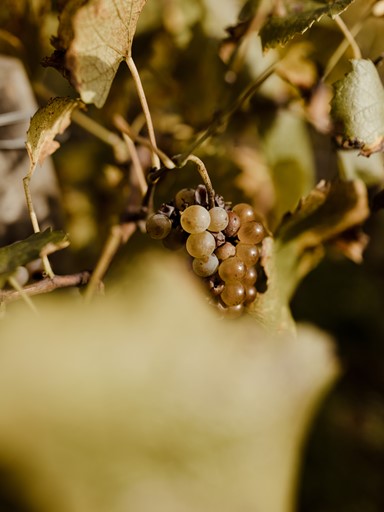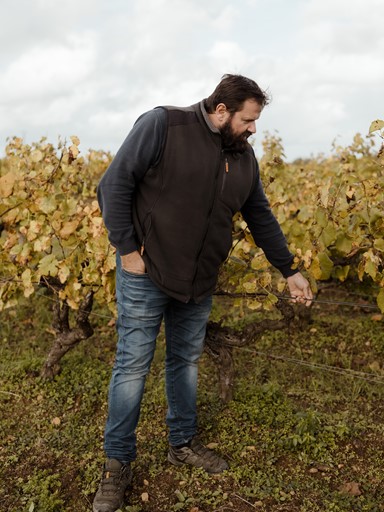
Fighting Frost
Domaine de Bellevue, Loire, France
Finding His Way...
In the western part of the Loire Valley, a maritime climate created by the nearby Atlantic Ocean means generally mild winters and summers and less extreme temperature changes. However over the last decade, frosts in the spring – the vital budding season – have become an increasingly common enemy.
Early frosts are one of the greatest challenges winemakers face, as even just one bitterly cold night can destroy an entire crop. The myriad of preventative measures available often carry high price tags and environmental impact. But one of our popular Loire winemakers, Jerôme Bretaudeau of Domaine de Bellevue, has embraced a new energy-efficient alternative that he thinks ensures the future of his domaine, and is kinder to the planet...
A Frost Event
In the winter, grape vines go dormant and are able to withstand cold temperatures, down to around -15°C or more depending on the variety.
In the early spring, a prolonged period above a certain temperature tells the vines it is time to wake up and they begin producing buds. These buds will go on to provide the season’s shoots, leaves, flowers and ultimately grapes.
However, these young tissues are vulnerable and if temperatures drop below critical levels, usually 0°C, ice crystals form inside cells, which damage the cells and can cause tissue death. Buds hit by frost will shrivel and brown, destroying the potential crop for the whole year, and requiring significant rehab in order to prepare of the next growing season.
Sadly, once frost damage occurs, there is little that a vigneron can do. So they must protect the vines at all costs - which often means long, sleepless nights trying their luck with a variety of expensive and less-than-ideal practices.

Protection Methods
Most vignerons use bougies, candles that are lit in the vineyards in the early morning to increase temperatures. They are easy to install, but a single hectare requires approximately 200 candles, which are expensive to purchase and require long hours to place, light, and later collect. And while dramatic photos of candle-lit vineyards look great on social media, the cloud of smoke that hangs over the parcels the next day is the hard reality.
There are several air circulation methods, which mix the warmer layers of air at higher altitudes with the cold air closer to the ground. Wind machines, gas blowers and helicopters are effective, but all have a great deal of wastage and significant environmental impact.
Another solution uses water sprinklers for a technique called aspersion. The water freezes around the shoots and protects shoots from damage. But a great deal of water is required, and wasted, and it is only possible where pipes and sprinklers are permitted and have been installed.
In Muscadet, the challenge is especially complex, as the area has been battered by spring frosts over several vintages, yet the traditionally low prices of these wines mean slim profit margins and little excess capital. This is a region dominated by small family wineries, and battling frost events can wipe out any cash reserves as quickly as the frost itself wipes out the vines. Domaine de Bellevue was hit especially hard by spring frosts over the last decade. Jerôme lost much of his production in 2016, 2017 and 2019. In 2021, he was unable to make three of the nine wines he usually produces. He knew he had to do something or he would have no future. “There is no price equal to having no harvest” he says.
Jerôme's Solution
Instead of relying on temporary fixes, Jerôme sought a long-term solution, ideally one better-aligned with his biodynamic mindset. He found the answer in a new system called "fil chauffant" (heated wire), which heats the vines through a tiny electric wire. A heating cable with a low wattage output is fixed onto the existing trellis wires. The cable is wrapped around the vine’s fruiting cane, the young canes that will produce the current season's fruit, and the heat from the wire is conducted into the sap of the cane. Because sap is a good conductor of heat, it is able to evenly distribute this heat to the new buds internally and protect them from the freezing temperatures.
The system also requires hardly any effort to implement. Each row of vines has a thermostat, and when the temperature drops below 0°C, the system automatically sends a low level of heat into the wires throughout the night. There is no wastage, as heat is sent only when the temperature has fallen below critical and only where it is needed. An entire vineyard can be connected by buried wires, leaving little visual evidence – a stark contrast to the wind towers that now dominate many Loire vineyard vistas. And there are no stressful all-night marathons, which Jerôme jokingly says is his favourite advantage!

Future Proofing
Jerôme is extremely pleased with the results of the system so far, and would ideally like to implement it on all of his 15 hectares. But the up-front costs are high and the cables can be difficult to install on steep terrain. So for the moment he uses the heated wire system in combination with wind machines, and in a few areas he also uses candles. But he insists the wire heating is the most reliable and efficient solution and sees it as a sound long-term investment. And the key to ensuring he can continue to create his cult-favourite wines from the rich terroir of Muscadet.
Images by Audrey Dubessay
Words by Allison Burton-Parker
Wines by Domaine de Bellevue







